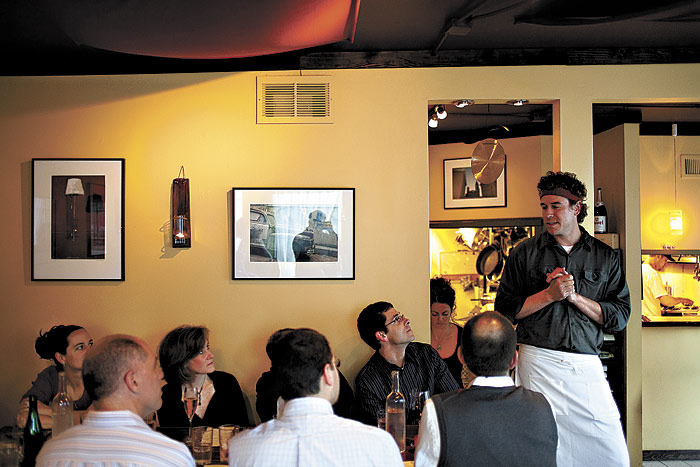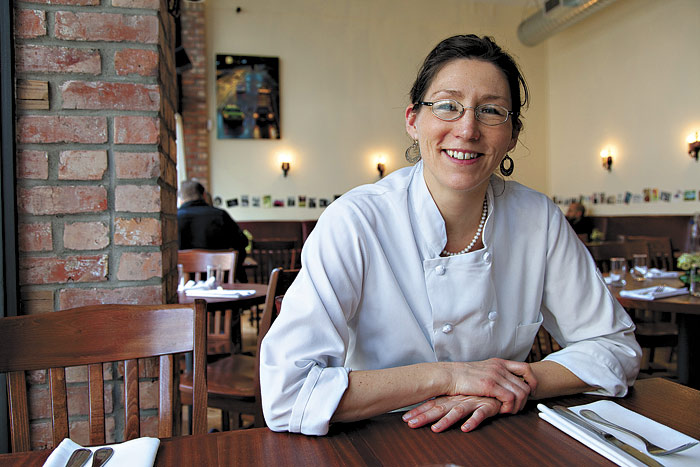Scientists love to prove the intuitively obvious. Last year, researchers offered empirical proof that women’s brains were different from men’s brains. There are substantially more neural connections between the hemispheres of a female brain, they said, thus breathing new life into that cliché about a man’s one-track mind. Women and men, they proclaimed, do think differently.
Which, by logical extension, means they dress differently, talk differently, move differently, and, on some elemental level, eat differently as well.
You are about to read a manifesto on Eating as a Gendered Activity. Stereotyping runs rampant throughout, and will prompt the more enlightened and sensitive among you to write letters.
Thesis no. 1: Men eat according to appetite. Women eat according to mood.
Men eat when they feel hungry. Women eat when they feel like it, and then they eat only what they feel like eating. Hunger has nothing to do with their eating. If a woman feels like eating nothing in particular, she will have a bowl of cereal for dinner. Or chocolate. Or ice cream. Pregnancy intensifies this eating moodiness to extreme levels.
Thesis no. 2: For men, food is fuel. For women, food is feeling.
Men eat to sate their hunger; then they go about their business. Women eat and feel either virtuous or guilty, good or bad, or happy or sad about what they ate. The next thing a woman eats is determined by how she wants to adjust her feelings about her previous gustatory misadventure. Put another way: Men simply eat, and women spend a lot of time and energy thinking about eating before and after doing it. Body image plays a significant role in this difference; women have been conditioned to aspire to something unnatural.
Thesis no. 3: Men believe food is for the body. Women believe food is for the spirit—and is bad for the body.
Women believe that everything affects the spirit—and, since it’s true that everything does, this should come as no surprise. Women know this to be true because their own bodies are a source of food. Men, who cannot suckle others, are natural-born skeptics on the spirituality-of-food question, which is why they can only crave and respond to food with their unthinking stomachs.
Men know all this about women, and it drives them crazy. Women also know all this about men… and it drives them crazy.
If you accept these three key differences between the way women and men eat, then you will accept that certain cuisines have gender. Some of these genders are intuitively obvious: French and Japanese foods clearly are feminine. British and German foods are obviously masculine.
Italian food—ha! That one’s not obvious at all. Italian food mingles feminine and masculine traits into one glorious cuisine. Pasta is the ne plus ultra of femininity, a mighty shank of osso bucco, the ultimate guy food. Chinese, like Italian, is a hermaphrodite cuisine. Korean? Kimchi is guy food. Scandinavian? “Lutefiske”—need I say more? Indian, gal. Mexican, guy. . . .
American food: Hamburger, pizza, barbecue, cornbread, corn on the cob . . . surely this needs no elucidation.
When going on a first date, a sensitive man will take a woman to a womanly restaurant. The average man will choose Italian. The clueless one will choose a brewpub.
If for some bizarre reason you can’t figure out which gender pertains to American food, consider this: America’s most significant contribution to world cuisine is Fast Food. Fast-food chains invade, colonize, and march on to virgin territory with the single-minded goal of replicating themselves. Fast food is about lucre, not sustenance. Hooters, when you get right down to it, is the only fast-food chain honest about its intentions: They know you want some shake with those fries.
It used to be that women cooked at home, and men cooked in restaurants. Women cooks were doing their chores; men cooks were plying their profession. This is no longer true. Cooking is now a leisure activity, with requisite new equipment, classes, books, glossy magazines, TV shows, celebrities, and trends. Everyone is cooking fancy foods, following the direction of others. Everyone measures; few people cook by instinct.
But because of genetic hard-wiring, we will never stop eating by instinct. It’s an oddly comforting thought: We talk to each other across a Great Cranial Divide, but we still manage to sit down together at the same table.






